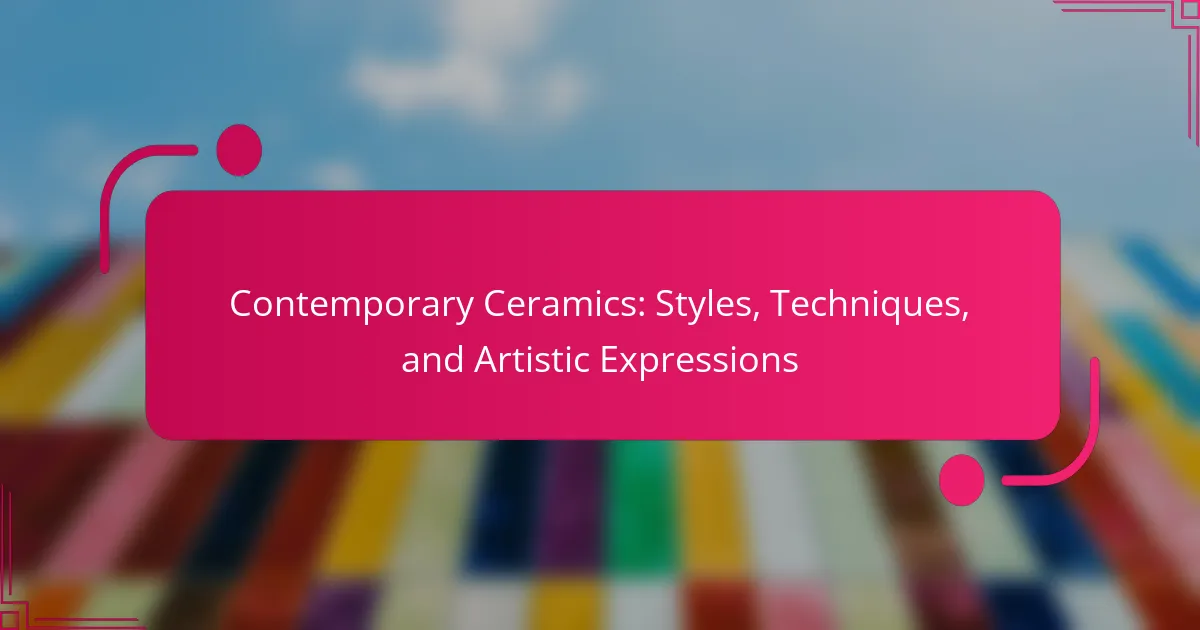Contemporary ceramics offer a vibrant exploration of artistic expression through innovative styles and techniques. This article examines key characteristics, including minimalism and bold colours, the integration of mixed media, and the challenges faced by artists. It also highlights unique approaches that reflect personal narratives and cultural identities, as well as the impact of technology on the craft.
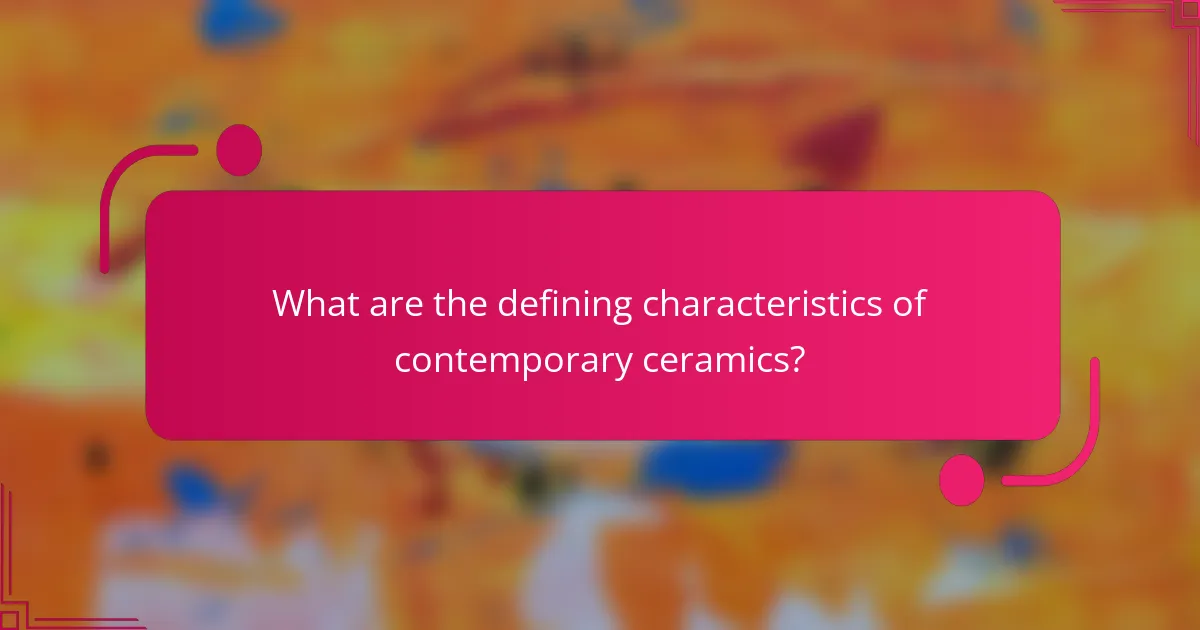
What are the defining characteristics of contemporary ceramics?
Contemporary ceramics are characterised by innovation, diversity, and a blend of traditional and modern techniques. Key characteristics include unique artistic expressions, experimentation with forms and materials, and a focus on sustainability. Artists often incorporate mixed media and technology, pushing the boundaries of conventional pottery. The emphasis on personal narrative and cultural commentary further distinguishes contemporary ceramics, making each piece a reflection of individual creativity and social context.
How do materials influence the creation of contemporary ceramic art?
Materials significantly shape contemporary ceramic art by influencing texture, form, and colour. Different clays and glazes provide unique properties that artists exploit for creative expression. For instance, stoneware offers durability, while porcelain allows for intricate designs. The choice of material often reflects the artist’s intention, whether aiming for functionality or pure aesthetic. Innovative techniques, such as 3D printing and alternative firing methods, further expand the possibilities, allowing for unprecedented forms and surface treatments. This dynamic interplay between materials and techniques defines the evolving landscape of contemporary ceramics.
What role does technology play in modern ceramic techniques?
Technology significantly enhances modern ceramic techniques by introducing innovative tools and processes. Advanced equipment like 3D printers enables precise designs and complex shapes that traditional methods cannot achieve. Digital modelling software allows artists to visualise their work before production, reducing material waste. Additionally, temperature-controlled kilns ensure consistent firing results, improving the durability and quality of ceramics. These technological advancements not only expand artistic possibilities but also streamline production processes, making contemporary ceramics more accessible and diverse.
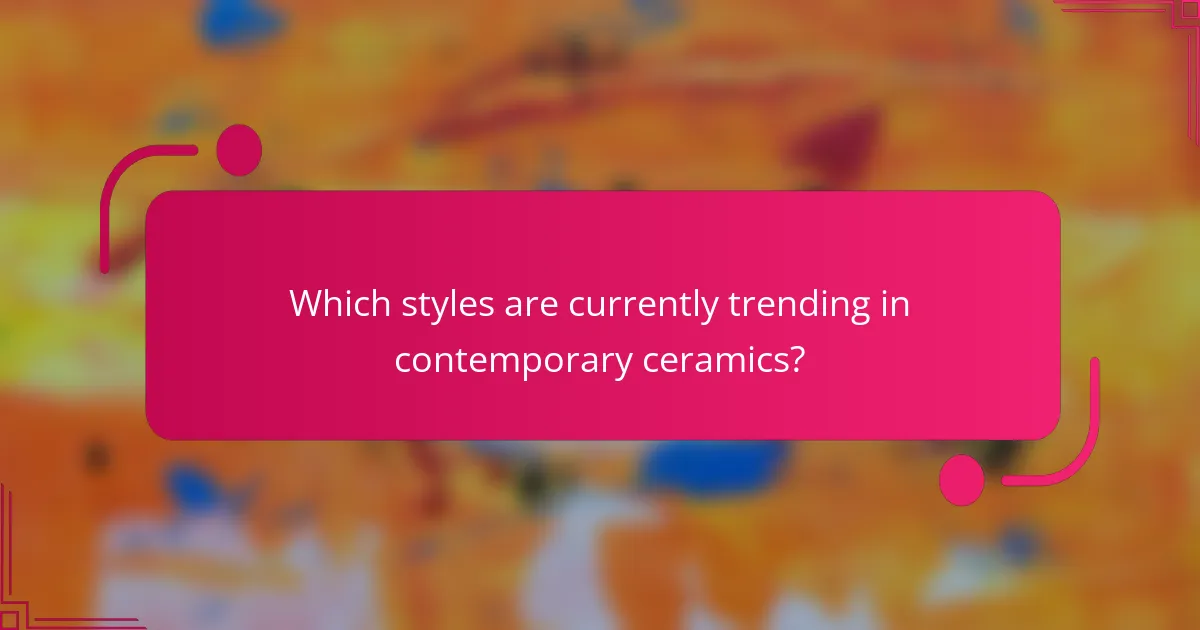
Which styles are currently trending in contemporary ceramics?
Contemporary ceramics currently trend towards minimalism, organic forms, and bold colours. These styles emphasise functionality while showcasing artistic expression. Unique attributes include the integration of mixed media and sustainable materials, reflecting environmental consciousness. Rare techniques involve experimental glazing and 3D printing, pushing the boundaries of traditional craftsmanship.
How does functional pottery differ from sculptural ceramics?
Functional pottery serves practical purposes, while sculptural ceramics emphasise artistic expression. Functional pottery includes items like bowls and mugs designed for everyday use, focusing on usability and durability. Sculptural ceramics, however, prioritise aesthetics, often taking abstract or conceptual forms that may not serve practical functions. This distinction highlights the unique attributes of each style, where functional pottery is rooted in utility and sculptural ceramics in artistic exploration.
What are the influences of cultural heritage on contemporary ceramic styles?
Cultural heritage significantly influences contemporary ceramic styles by shaping techniques, aesthetics, and themes. Traditional methods and motifs are often integrated into modern practices, creating a dialogue between past and present. For instance, artisans may draw on indigenous patterns or historical glazing techniques, resulting in unique artistic expressions. This synthesis not only preserves cultural identity but also innovates within contemporary art. The use of locally sourced materials further connects ceramics to specific cultural narratives, enhancing their significance in today’s art world.
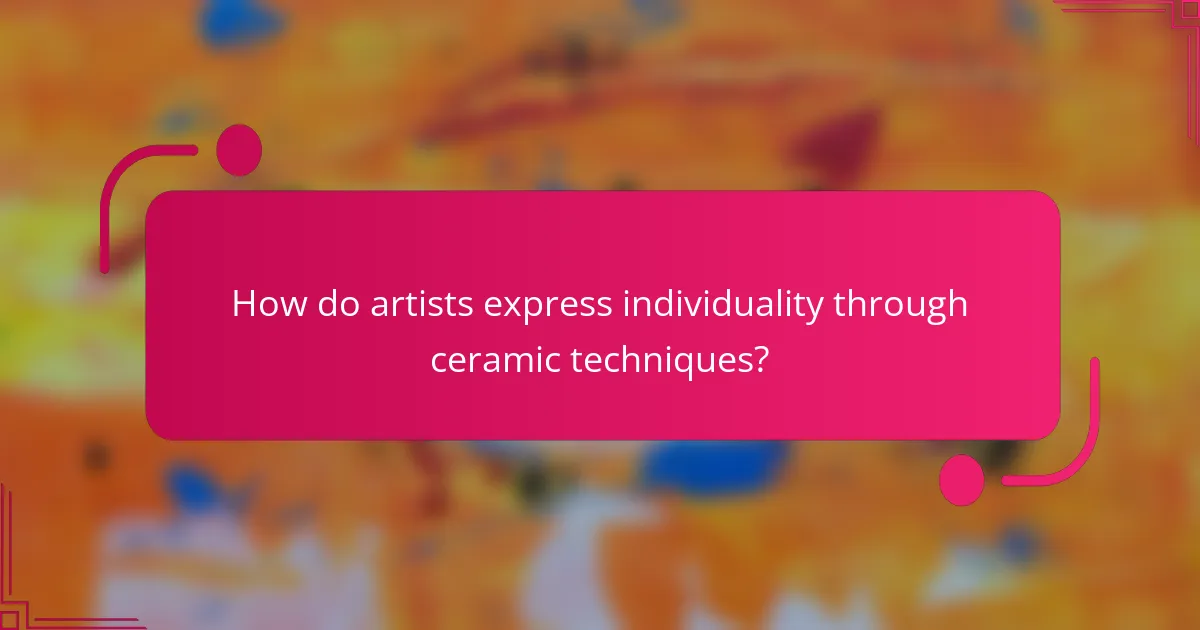
How do artists express individuality through ceramic techniques?
Artists express individuality through ceramic techniques by employing unique glazing methods, innovative forms, and personalised firing processes. These elements allow for distinct visual and tactile experiences. For example, hand-building techniques enable artists to create one-of-a-kind shapes that reflect their personal style. Additionally, the use of unconventional materials can lead to rare textures and finishes, further showcasing artistic identity. Through these diverse approaches, contemporary ceramics become a medium for personal expression and storytelling.
What are the most popular glazing methods used today?
The most popular glazing methods today include glossy, matte, satin, and transparent glazes. Each method offers distinct aesthetic qualities and functional properties.
Glossy glazes provide a high-shine finish, enhancing colour vibrancy. Matte glazes offer a soft, non-reflective surface, ideal for subtle designs. Satin glazes strike a balance between glossy and matte, providing a slight sheen. Transparent glazes allow the underlying clay body or decoration to show through, adding depth to the piece.
These glazing techniques are essential for contemporary ceramics, influencing both visual appeal and durability.
How does surface texture affect the aesthetic of ceramic pieces?
Surface texture significantly influences the aesthetic appeal of ceramic pieces by enhancing visual interest and tactile experience. Varied textures can evoke different emotions and perceptions, making pieces more engaging. For instance, a rough surface may suggest rustic charm, while a smooth finish can convey elegance. Unique attributes like intricate carvings or glazing techniques further differentiate individual works, allowing artists to express their unique styles. Textures can also reflect the intended use of the ceramic, ranging from decorative to functional. Overall, surface texture plays a crucial role in defining the artistic expression within contemporary ceramics.
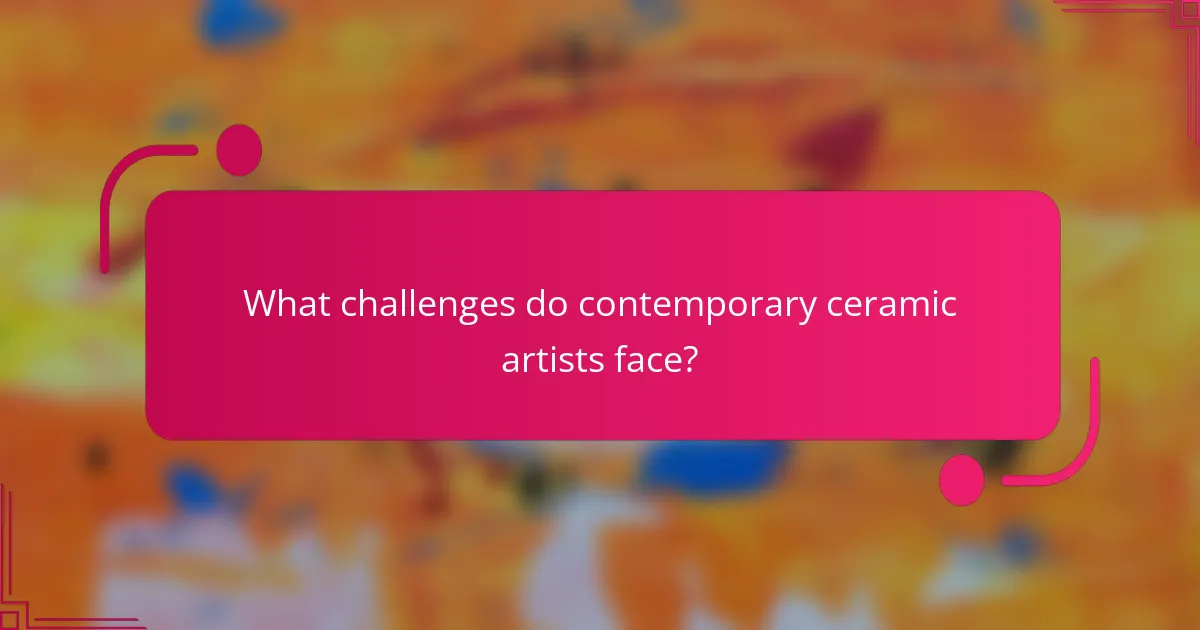
What challenges do contemporary ceramic artists face?
Contemporary ceramic artists face numerous challenges that impact their creative processes and market presence. The primary issues include financial constraints, limited access to materials, competition from mass-produced ceramics, and the need for continuous innovation.
Financial constraints often hinder artists from acquiring high-quality materials or investing in equipment. Limited access to unique glazes and clays can restrict artistic expression. Competition from mass-produced ceramics poses a challenge, as consumers often prefer lower prices over handmade quality. Lastly, the need for continuous innovation pushes artists to explore new techniques and styles, which can be both demanding and risky.
How do environmental concerns shape the practices of ceramicists?
Environmental concerns significantly influence ceramicists by promoting sustainable practices and materials. Many artists now prioritise eco-friendly clay sources and non-toxic glazes, reducing their environmental footprint. Additionally, the use of recycled materials in ceramic art has gained popularity, showcasing a commitment to sustainability. This shift not only addresses ecological issues but also resonates with consumers who value environmental responsibility in art. As a result, contemporary ceramics increasingly reflect a balance between artistic expression and environmental stewardship.
What are common misconceptions about contemporary ceramics?
Common misconceptions about contemporary ceramics include the belief that it is primarily functional, that all pieces are mass-produced, and that ceramics lack artistic merit. Many assume ceramics only serve practical purposes, neglecting their role in fine art. Additionally, some people think contemporary ceramics are uniform and lack diversity, when in fact, artists employ various techniques and styles, resulting in unique expressions. Finally, there is a misconception that ceramics are less valuable than other art forms, despite significant contributions to the art world by contemporary ceramicists.
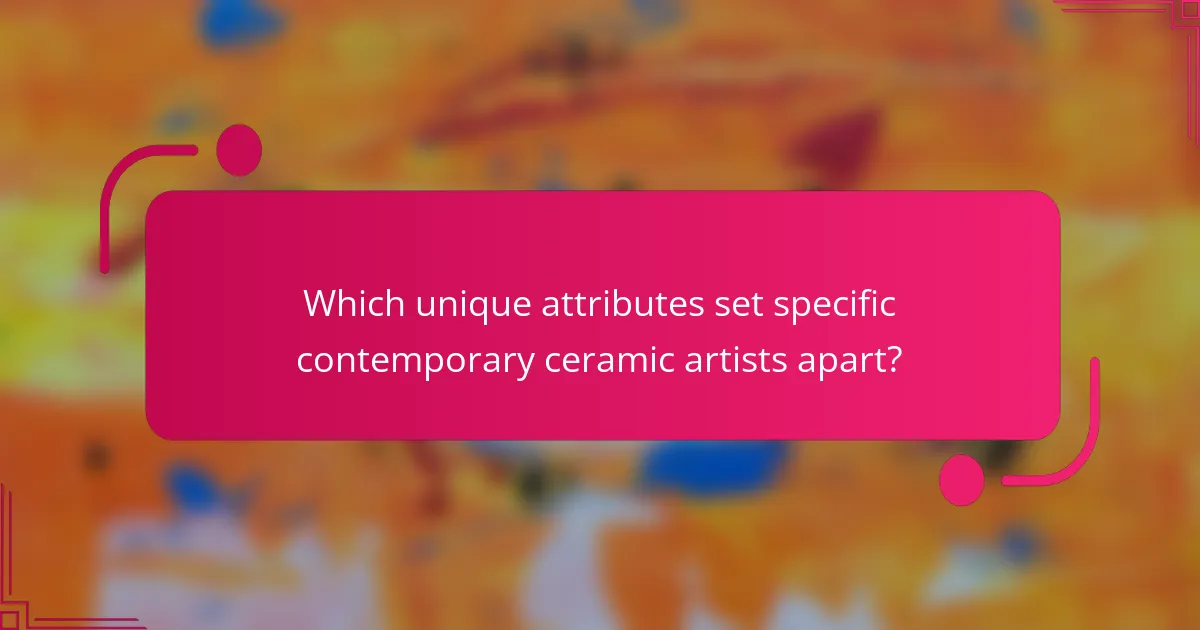
Which unique attributes set specific contemporary ceramic artists apart?
Contemporary ceramic artists are distinguished by their innovative techniques, unique materials, and personal narratives. These attributes create a diverse landscape within the medium.
One unique attribute is the use of unconventional materials, such as recycled elements or mixed media, which allows artists to challenge traditional boundaries. For example, artists like Grayson Perry incorporate textiles and found objects into their ceramic works, creating a dialogue between different art forms.
Another unique aspect is the exploration of cultural identity and personal history. Artists often embed their backgrounds and experiences into their pieces, resulting in works that resonate on a deeper emotional level. This approach can be seen in the work of artists like Magdalene Odundo, who draws from her African heritage to inform her contemporary designs.
Lastly, the integration of technology in ceramics is a rare attribute that sets some artists apart. Techniques such as 3D printing and digital design enable new possibilities in form and structure. Artists like Jonathan Keep utilise these technologies to push the limits of traditional ceramics, creating intricate and innovative pieces.
How do personal narratives influence ceramic artworks?
Personal narratives significantly influence ceramic artworks by providing unique perspectives and emotional depth. Artists often draw from personal experiences to convey their stories through form, colour, and texture. This approach allows for a deeper connection between the artwork and the viewer, enriching the narrative quality of contemporary ceramics. By incorporating elements of their life stories, artists create pieces that resonate on a personal level, making each artwork distinct and meaningful. Such narratives can reflect cultural heritage, personal struggles, or transformative experiences, thus enhancing the overall impact of the ceramic art.
What rare techniques are being explored by avant-garde ceramicists?
Avant-garde ceramicists are exploring rare techniques like 3D printing, smoke firing, and incorporating digital technology. These methods push the boundaries of traditional ceramics and offer unique aesthetic possibilities.
3D printing allows for intricate designs that were previously impossible. Smoke firing creates distinctive surface effects, enhancing the visual appeal of pieces. Digital technology enables innovative approaches to glazing and surface decoration, merging art with technology. This experimentation reflects a growing trend in contemporary ceramics, where artists seek to redefine material boundaries and artistic expression.

What are the best practices for engaging with contemporary ceramics?
To engage effectively with contemporary ceramics, focus on exploring diverse styles, mastering various techniques, and appreciating artistic expressions. Emphasise hands-on experiences, such as workshops or studio visits, to deepen understanding. Collaborate with artists to gain insights into their creative processes. Attend exhibitions to witness trends and innovations firsthand. Finally, share your experiences through social media to connect with a broader community and foster discussions around contemporary ceramic art.
How can collectors evaluate the value of contemporary ceramic art?
Collectors can evaluate the value of contemporary ceramic art by considering factors such as the artist’s reputation, rarity, and the piece’s condition. The artist’s background and previous sales can influence perceived value. Rarity is significant; limited editions or one-of-a-kind works often command higher prices. Additionally, the piece’s condition, including any damage or restoration, impacts its market value. Understanding the techniques and styles used can also provide insight into the artistic merit and potential appreciation over time.
What tips can enhance the appreciation of ceramic art in everyday life?
To enhance the appreciation of ceramic art in everyday life, engage with the art through personal experience and education. Visit local galleries and studios to observe diverse styles and techniques. Participate in workshops to gain hands-on knowledge and create your own pieces. Incorporate ceramic art into your home decor, showcasing functional and decorative items. Discuss the history and cultural significance of ceramics with others to deepen understanding and appreciation.
